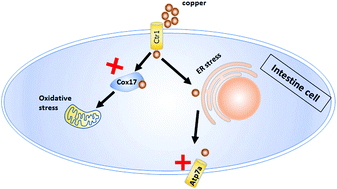Copper nanoparticles induce zebrafish intestinal defects via endoplasmic reticulum and oxidative stress†
Abstract
As an essential trace element, copper plays key roles in the activation of multiple enzymes, neurotransmitter biosynthesis and denaturation, as well as the decomposition of superoxide and the synthesis of collagen. The intestines is the main organ for copper absorption and transfer, and intestinal copper accumulation is observed in some patients with gene mutations. However, a vertebrate model to link copper accumulation with intestinal diseases and defects is still lacking, and the data concerning the mechanisms underlying this link are still scarce. In this study, the effects of exogenous copper (CuNPs or their released Cu2+) on intestinal development in zebrafish embryos were investigated after their exposure to copper. The results showed that over 0.10 mg L−1 of CuNPs or Cu2+ damaged the zebrafish intestinal development, including thinned epithelial cells as well as few and shortened intestinal villi. Under CuNP stress, the expression was significantly (p < 0.05) reduced for the intestinal marker genes (slc15a1b, cyp3a65, cyp8b1, fabp2), but increased for the endoplasmic reticulum (ER) stress marker (bip) in the zebrafish intestines. Additionally, immunofluorescence analysis revealed that CuNPs or Cu2+ induced the production of ER stress (indicated by PDI) and oxidative stress (indicated by 4-HNE) in the intestinal cells. The expression of the aforementioned intestinal marker genes could be restored to normal by inhibiting the production of ER stress or oxidative stress with ER stress alleviator PBA (4-phenylbutyric acid) or ROS scavengers GSH (reduced Glutathione) or NAC (Nacetylcysteine) in CuNP or Cu2+ stressed embryos, suggesting that copper induces intestinal defects mainly by ER and oxidative stress. Moreover, obvious intestinal defects were observed in copper-stressed cox17−/− and atp7a−/− mutants, implying that blocking the transportation of copper to the mitochondria or trans-Golgi network by deleting cox17 or atp7a could not alleviate copper-induced intestinal developmental defects. This is probably the first report to reveal that copper nanoparticles (CuNPs) and their released ions (Cu2+) cause intestinal developmental defects via inducing ER and ROS stresses. It is also the first report on the intestinal developmental responses of cox17−/− or atp7a−/− mutants to copper stimulation.



 Please wait while we load your content...
Please wait while we load your content...